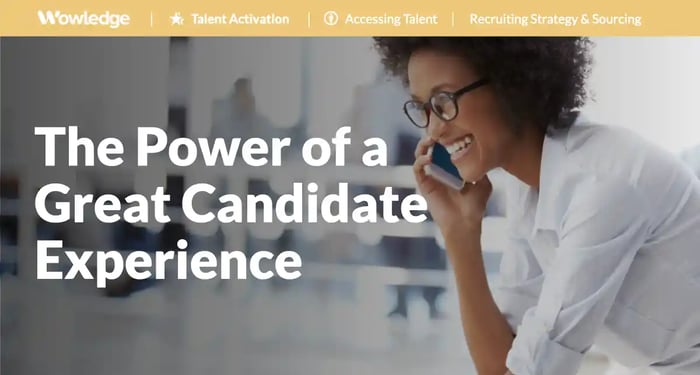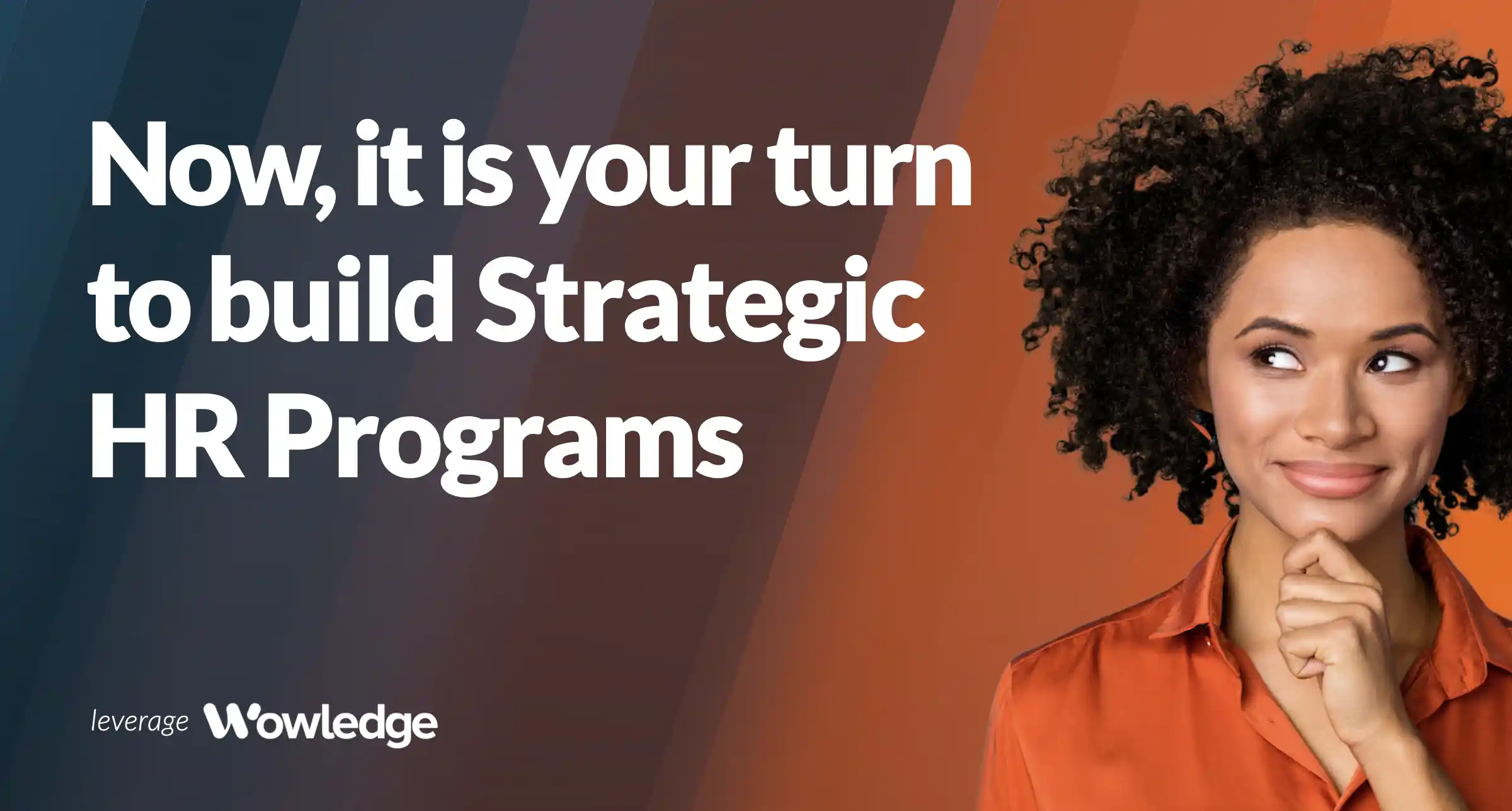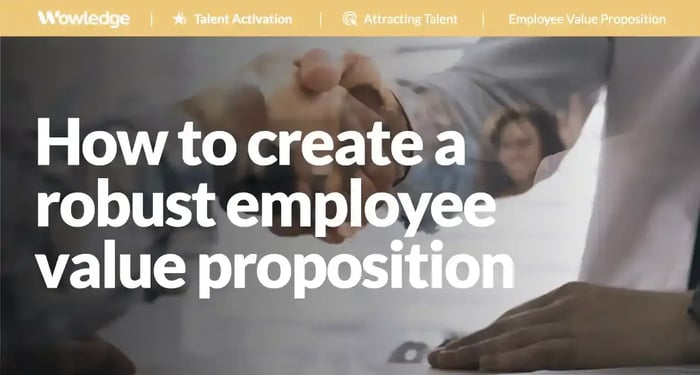Table of Contents
- What is a “candidate experience”?
- Why is the candidate experience important?
- A bit about candidate preferences
- The elements of creating a great candidate experience
- 1. An informative and instructive career site
- 2. Articulation of an employer brand and employee value proposition
- 3. Developing a relationship with candidates
- 4. Informative and comprehensive job postings
- 5. A streamlined application progression
- 6. A smooth and well-designed screening and interview process
- 7. Reliable, timely, and meaningful communications
- 8. Onboarding that provides a welcome and drives retention
- 9. A candidate experience integrated into HR- and hiring manager-related KPIs
- Relevant Practices & Tools
- FAQs
-
Given the well-documented challenges organizations face in hiring and maintaining sufficiently sized and skilled workforces, they increasingly recognize the pivotal role a superior candidate experience plays in attracting and retaining top-notch talent. Beyond being a mere courtesy, a positive candidate experience is a strategic imperative that directly impacts a company's ability to meet its objectives. As organizations continue to grow and work to meet their staffing needs, understanding the tangible benefits of investing in a candidate-centric approach becomes paramount. From enhancing employer branding to reducing time-to-fill and fostering a positive organizational reputation, the dividends of prioritizing candidate experience extend far beyond the confines of the recruitment process.
However, to cultivate an exceptional candidate experience, it is critical to understand the nuances of job candidates' experiences and preferences. The modern job seeker is not merely a passive participant; they are discerning consumers evaluating potential employers just as rigorously as companies assess them. Looking at the realities faced by job candidates, from the initial point of contact to the final decision-making phase and onboarding, organizations can build an appreciation of how to tailor their recruitment strategies best to resonate with top talent, ultimately elevating their employer brand and positioning themselves as employers of choice. As the job market continues to evolve, it becomes imperative for businesses to continuously evaluate and recalibrate their approaches to place the candidate at the forefront of the recruitment journey.
What is a “candidate experience”?
The candidate experience refers to individuals' perceptions and interactions with an organization's recruitment and hiring processes. It encompasses every touchpoint a candidate has with an employer, from initial awareness of a job opportunity through the application and interview stages, to the final decision-making and onboarding phases. It is characterized by seamless processes, ease of interaction with the organization's automated systems, positive and engaging interactions with its people, and optimized access to information related to the company, function, department, manager, and teammates.
Like a high-quality customer experience, a positive candidate experience contributes to favorable impressions of the company, its culture, and the quality of its products and services. Similarly, it is linked to employee experience, where a positive one leads to favorable impressions of the company’s leadership, culture, career opportunities, and work environment.
Organizations that prioritize candidate experience recognize its critical impact on their employer brand and the ability to attract and retain top talent. A positive candidate experience not only contributes to a favorable reputation in the job market but can also enhance the likelihood of candidates accepting job offers and, in turn, positively influence employee engagement and retention. In contrast, a negative candidate experience can lead to reputational damage, the loss of potential talent, and even dissuade individuals from becoming customers or advocates of the organization. Therefore, organizations are increasingly optimizing their recruitment processes to ensure a positive, engaging experience for candidates throughout the process.
Why is the candidate experience important?
The benefits of a positive experience
The candidate experience is a critical element of a quality talent attraction and acquisition process. The primary issue is the intense global competition for talent, with the highest talent shortages in the past 16 years. 75% of U.S. companies experienced significant hiring obstacles, and 10.7 million jobs were unfilled in 2022. Worker mobility has skyrocketed over the past few years, with the U.S. Chamber of Commerce reporting that more than 50 million workers quit their jobs in 2022, and 47.8 million switched roles in 2021. While the trend is easing (estimated at 43 million for 2023), the number of open jobs remains substantial.
Further exacerbating the issue is the labor market participation rate, which measures the volume of people who can but are not actively working, contributing to open jobs across industries continuing to exceed the labor supply. In fact, labor force participation has dropped from 67% in 2001 to 62.8% in December 2023, a shortfall of 1.27M workers. Interestingly, the greatest shortages occur in professional and business services (55% of jobs unfilled) and in financial activities (40% unfilled). Boiling it down, there are only 72 workers for every 100 open jobs in the U.S.
An abundance of research has demonstrated that companies providing a positive candidate experience significantly improve their ability to hire the “best and the brightest” significantly. For example, such organizations have been found to increase the quality of hire by 70%. Over 91% of experienced HR professionals asserted that “the quality of candidate experience has a direct impact on quality of hire,” (although only 42% have designed and tracked candidate experience, which represents missed opportunities for improvement. Research by Glassdoor found that organizations investing in candidate experience were able to improve the quality of hires by 70%.
Further advantages include higher offer acceptance and candidate attraction rates, greater future candidate referrals, and lower new-hire turnover rates. For example, 80% of candidates reported that a positive experience influenced their decision to accept a job offer. LinkedIn found similar results: 87% said a good experience would lead them to accept the offer. 88% of applicants who had a good experience said they were more likely to encourage others to apply, while 80% of those who did not receive an offer said they would apply again. Organizations with strong onboarding processes increased new hire retention by 82% and improved productivity by 70%.
Other studies have also shown that a good experience as a candidate can influence overall perceptions of the organization, such as 71% of satisfied candidates being more likely to buy the company’s products or services. Furthermore, 57% of job candidates indicated that they posted a review after a positive experience, and 28% left a negative one. Negative reviews pose a threat, as future job seekers increasingly rely on such information when applying for jobs.
The drawbacks of a poor candidate experience
A negative candidate experience, while frustrating and oftentimes upsetting to candidates, can lead to serious consequences for the organization. The rate of occurrence is surprisingly high – for example, 48% of job seekers reported having one or more negative experiences while applying for jobs in the prior year, and 49% of candidates reported turning down a job offer due to such a poor experience. They reported that people were influenced by poor impressions of the people they interacted with or interviewed, the workplace itself, and the inefficiency and disorganization of the interview process. Further research found that 59% of candidates had a bad experience applying for a job online.
And the impact of such experiences is important, particularly in a tight labor market where replacing long-term employees is difficult and expensive. New-hire turnover is especially painful – for hiring managers and recruiters who must repeat the lengthy, labor-intensive process, for co-workers who must live with related productivity and workload challenges, and for the company, which has to re-spend overhead budget dollars. Research found that organizations offering poor hiring and onboarding experiences are 50% more likely to experience high turnover, and that 80% of new hires with a poor onboarding experience plan to look for a new opportunity elsewhere. In fact, among those reporting a plan to “leave soon,” 74% said the onboarding experience was boring, 66% found it confusing, and 64% considered it a failure.
Not surprisingly, a poor experience directly impacts the organization’s ability to attract future candidates, with over 50% of candidates declining to apply for a job after reading negative reviews on employer review sites like Glassdoor and JobSage. One study found that 77% of candidates with a bad experience will actively share it with their networks, and another reported that 72% of candidates share negative experiences with family and friends, 25% will “actively discourage others” from applying, and 41% of rejected candidates with a poor experience say they will be less likely to do business with such companies. And 83% of surveyed job candidates indicated that an interview experience that failed to meet their expectations could negatively influence a role or company they “had initially liked.”
The findings are sobering and should act as a massive incentive for organizations to evaluate their processes from a candidate’s perspective and regularly monitor and structure them to make the process frictionless and pleasant. Perhaps the key is to think of the process as less of a job and more of an opportunity to impress and make a good friend.
A bit about candidate preferences
Understanding the candidate is the same as a B2C company seeking to better appreciate its current and potential customers' preferences, biases, and purchase patterns. No detail is too small in a highly competitive environment, whether it involves a job, a bag of cookies, or a laptop. Using design thinking or related methodologies, a recruiting process can be created that simultaneously meets business and end-user requirements. Actively seeking out and listening to the opinions and preferences of job candidates (including recent hires) can yield a more responsive and effective experience for future candidates.
Some interesting findings about candidate desires and behaviors will help to inform best practices in candidate experience. For example, understanding that:
- 45% of candidates reported that an employer had ghosted or stopped all communications.
- Over 70% of job seekers said they will not submit a job application if it takes more than 15 minutes to complete.
- 58% of candidates expect to hear back on their initial application within one week.
- More than 70% want feedback from their interview process, even if it did not result in a job offer
- 86% consider a company’s commitment to DEIB a major decision factor.
- The majority of Glassdoor users surveyed read at least 7 reviews before forming an opinion of a company. Build a robust and positive experience!

The elements of creating a great candidate experience
As we’ve defined, the experience covers all activities and interactions a candidate has with the organization, from initial awareness to onboarding. While there is a lot to unpack, some actions can be taken to build an experience tuned to the needs of the individuals involved. The primary and overarching building blocks can actually (and ideally) be drawn from an organization’s values—respect for the individual, integrity, honesty, and transparency in the relationship, compassion, regard for individual differences, etc. These can be augmented with business values such as process efficiency, brand image and integrity, customer focus, community partnership, etc.
Driven by alignment with corporate values and consistency with brand, various leading practices can be adopted (and adapted) to establish a more robust, positive, and meaningful experience for job candidates.
1. An informative and instructive career site
The career site should be engaging and informative, drawing the user into a wide range of insights into the company, its strategic purpose and intent, its values, its work culture, its workplace, how it interacts with the community, and what it values most in its employees. It should go well beyond a mere listing of open jobs by providing a broad picture of its employee value proposition, benefits, skills, and career development opportunities, employee engagement (social, demographic) activities and programs, facilities descriptions (or walk-throughs), and major policies (remote/hybrid work, parental leaves, etc.). Ideally, these are presented in multi-media formats and include interviews with current employees in targeted jobs, locations, etc.
2. Articulation of an employer brand and employee value proposition
Create a clear, actionable brand and employee value proposition (EVP) that guides the development and implementation of all employee-facing processes, practices, and programs. Use core values and competencies such as integrity, accountability, collaboration, innovation, development, curiosity, mentoring, respect, trust, and openness. and build those into talent management processes and performance expectations. Promote the brand and EVP in job postings, candidate communications, career promotions, and social media while leveraging them in screening questions and assessments, job interviews, promotion decisions, etc.
3. Developing a relationship with candidates
Avoid the “post and pray” mentality by engaging candidates (active or passive) in a series of conversations that guide them gently into a potential employment relationship. Patience is rewarded by a more gradual process of discovery by each party, with the candidate being made aware of the company, its EVP, plans and business directions, opportunities for growth, benefits of “membership”, and the company learning about the individual’s unique blends of experiences and skill sets, work and thinking styles, potential cultural fit, preferences and aspirations, etc. The deployment of a candidate relationship management (CRM) platform enables ongoing communication and exchanges, including the posting of recent company product/service advances, business growth, strategic directions, and notable employee achievements.
4. Informative and comprehensive job postings
Job listings should be candidate-centric, providing candidates with data and insights into the opportunity and the growth pathways associated with it. They should explain in clear and unambiguous language what the role is expected to accomplish, how it interacts and collaborates with others inside and outside the function/department, and how a job contributes to the company's mission, customer success, and the community as a whole. It should respect the desire for jobholders to have “meaning” in their work, with clarity on the value the role provides to the company and its stakeholders.
5. A streamlined application progression
An efficient job application process asks for less data input up front. Modern applicant tracking (ATS) and related systems can scrape data about an individual from the internet, requiring fewer data requests. Allowing candidates to provide data once through the use of integrated HR systems (e.g., ATS with HRIS), enabling their downloads of existing profiles (e.g., LinkedIn), and auto-capturing data as they work their way through the application process (e.g., confirming educational attainment prior to interviews, SSNs before finalizing offer packages). Applicants expect to use mobile-enabled apps, so having this capability is essential to providing a great candidate experience.
6. A smooth and well-designed screening and interview process
Whether engaging in remote, virtual, and/or in-person screening and interviewing activities, those should be well-planned and orchestrated. These should also include easy (and ideally automated) scheduling that aligns with the candidate’s calendar, periodic reminders, and links to all necessary resources (virtual meeting link, interview prep guides, event schedule, interviewers' names/roles/bios, and travel arrangements). Itineraries should be monitored and overseen, movement between interviewers should be guided, time should be set aside for breaks, and so on. Schedules should be designed to provide a range of appropriate (and trained) managers and employees for both discussions and questions related to the role, expectations, management style, colleagues, onboarding and development options, and the workplace that the candidate will encounter as a new hire. Core to this is the opportunity for the candidate to meet the right blend of people (level, role, demographics) to communicate a sense of the culture and realities of the role being taken on.
7. Reliable, timely, and meaningful communications
As the data suggests, candidates want timely feedback and yet often do not receive it. This includes system-generated confirmation of application receipt, application status information, timely feedback on general suitability for the role, decisions on interview selection, and section process outcomes. As has been seen, the desire for meaningful and compassionate feedback on the candidacy is paramount to all candidates, regardless of the outcome. Providing brief but personalized outcome feedback, with rapid decisions for those offered jobs, and rejected candidates being encouraged to apply for other jobs as appropriate. The use of a post-process survey asking for candidate feedback on their experience (regardless of where it ended) is an excellent ongoing source of data to refine the process.
8. Onboarding that provides a welcome and drives retention
The onboarding process should be defined as extending beyond first-day orientation, ideally lasting through the first year or further. It should focus on getting the new hire settled into their role and the organization, with a highly structured assignment of mentors, scheduled interactions with the hiring manager, and formal socialization into the culture/people/mission. Gallup research has confirmed that a critical aspect is developing a formal new-hire development plan that links the shortcomings identified in the selection process to the individual's career aspirations and available learning and development opportunities. These are especially critical for employees working remotely or in a hybrid location.
9. A candidate experience integrated into HR- and hiring manager-related KPIs
Establishing positive candidate experience ratings in Recruiter and Manager performance requirements is essential to ensuring that the process is managed smoothly and efficiently for all candidates. As it establishes the strength of the initial bonds between an employee and the company, the experience is often viewed as a harbinger of the longer-term employee experience (EX) and thus is a crucial aspect of employee retention. Regularly collecting and disseminating experience survey results, especially those collected from candidates who advance to different steps of the process, can reveal gaps to be addressed through redesign.
Relevant Practices & Tools
Crafting Job Profiles to Attract the Right Talent. >
A well-crafted job profile is a critical alignment and marketing tool to attract the right talent to the organization and to the position in particular... more »
Executing Effective Candidate Prospecting Campaigns to Fill Positions Successfully. >
Launching effective recruiting campaigns to target and attract highly aligned candidates for a job position requires structured practices as well as creativity and experimentation... more »
Advanced Diversity, Equity, and Inclusion Practices to Diversify the Workforce. >
Employers who understand the value of Diversity, Equity, & Inclusion (DEI) intentionally cultivate a workforce that reflects the diversity of our society... more »
Creating an Employee Experience that Bonds High Performers to the Organization. >
The employee experience constitutes the entire journey an employee takes with the organization. This includes everything from pre-hire to post-exit interactions... more »
The Individual Development Plan (IDP) Tool: Capture Targeted Employee Learning and Development Actions for a Performance Period. >
A plan of action to guide the employee throughout the coming performance period (e.g., year) as they continue to develop necessary knowledge, skills, abilities, and competencies... more »
FAQs
How can organizations shorten applications without increasing risk or bias?
High-friction data fields should be deferred until later stages and replaced with automated resume/CV parsing and candidate profile imports from social media sites. Compliance-required attestations (e.g., gender, nationality, race) can remain, but verifications of identity, education credentials, and employment history are best requested post-offer. Validated “knockout” questions aligned to minimum job requirements reduce noise without inviting bias. Continuous A/B testing of form length and question wording helps calibrate the optimal trade-off among brevity, speed, and assessment accuracy and quality.
What rejection practices preserve brand and keep top runners-up engaged?
Post-interview declines should be fast, competency-specific, and respectful, with clear guidance on when reapplication makes sense. Silver-medalist candidates benefit from a personalized follow-up that outlines their strengths, developmental suggestions, and relevant future potential roles with the company. Opt-in talent communities with periodic content tailored to their profile keep relationships warm. Closing the loop in a timely manner reinforces a respectful culture, signals operational excellence, and reduces negative word-of-mouth.
How can interviewers be trained and calibrated at scale without slowing hiring?
A short, required certification process covering structured interviewing, fair and equitable candidate scoring standards and methods, and legal guardrails sets the baseline. Shadowing or observing expert talent assessors and double-scoring initial interviews creates calibration data that can be reviewed against hiring outcomes (e.g., recommending candidates who subsequently become high-quality employees). Interview kits that are available online and on demand, with role-specific questions and anchored rating guides, increase reliability. Quarterly refreshers using anonymized clips help correct drift and maintain consistency.
Which metrics best capture the quality of a candidate experience?
A balanced scorecard blends efficiency, sentiment, and equity measures. Core metrics include application completion rate, step-to-step conversion, cycle time per step, service-level agreement (SLA) compliance for response times, and offer-acceptance rate. Sentiment can be tracked through post-step pulse surveys, candidate Net Promoter Score (cNPS), and analysis of open-text survey questions. Equity is monitored through pass-rate parity across demographics, accommodation turnaround, and interview panel diversity. Be sure to survey successful and rejected candidates for more balanced and useful insights.










